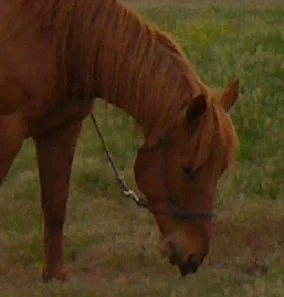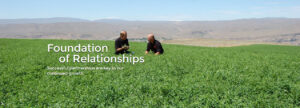 Recent warm days along with abundant rainfall have
Recent warm days along with abundant rainfall have
caused pasture grasses in the Pacific Northwest to explode into a lush green carpet. During the long, cold, and dreary winter, horse owners look forward to spring. Since most horse owners remove their horses from pasture during the winter to protect their pasture from damage – spring equals turnout! But, beware – danger may be lurking out in that emerald expanse.
The horse’s digestive system does not acclimate easily to sudden dietary changes. Abrupt turnout on lush pasture is almost certain to result in problems. Pasture grasses accumulate high levels of sugars during times of rapid growth. While simple sugars such as glucose and fructose are rapidly digested in the horse’s small intestine, fructan, a complex sugar, passes undigested to the large intestine where it is fermented into lactic acid by microbes. If a large amount of fructan-containing grass is consumed in a short period of time, a concentrated burst of lactic acid is released after microbial fermentation and cecal pH drops precipitously, which can lead to colic or laminitis.
Therefore, if a horse has been in a stall or a dry lot all winter, it is very important to slowly acclimatize him to spring pasture. Begin by turning the horse out to pasture for only 15 minutes a day, preferably after he has eaten his hay. Continue the 15 minutes of grazing for several days and then increase turnout time in 10 minute increments each day until the horse is grazing for 3 to 4 hours each day. Allow the horse to graze for 4 hours a day for about 2 weeks before turning him out to graze full-time.
Meanwhile, observe the horse daily for signs of colic (repeatedly laying down and getting up, pawing, biting at the flank, kicking at the abdomen, rolling more than normal) or laminitis (hind legs under the body with front legs extended out to the front, walking on eggshells, lying down and won’t get up). Remove the horse from pasture immediately and call your veterinarian if you suspect that your horse has colic or laminitis. If your horse is prone to laminitis, turnout during the spring is not recommended. Continue to feed these horses low-sugar hays such as Timothy Hay. Conversely, if your horse was not removed from pasture during the winter, he does not need to follow the above recommended spring pasture acclimatization protocol.
Are you ready for your horses to graze? Have you found a good schedule for reintroducing pasture? Share with us in the comment section.
Would you like to receive the blog via email? Subscribe above on the left.
]


